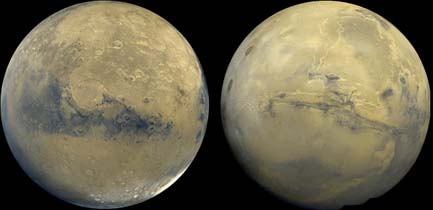
Views from the Viking Orbiters: centered on the Schiaparelli Crater (left) and centered on Valles Marineris (right).

Mars is about half the diameter of the Earth and has 1/10th the Earth's mass. Mars' thin atmosphere (just 1/100th the Earth's) does not trap much heat at all even though it is 95% carbon dioxide (CO2). The other 3% is nitrogen (N2). Because the atmosphere is so thin, the greenhouse effect is insignificant and Mars has rapid cooling between night and day. When night comes the temperature can drop by over 100 K (a 180° F drop)! During the winter the temperature can drop to as cold as -130° C (-202° F) that the carbon dioxide in the atmosphere actually freezes out, dropping the air pressure significantly. During the summer the temperature rises enough for all of the carbon dioxide to sublimate back into the atmosphere. Large pressure differences between the north and south hemisphere result during the winter/summer months.The large temperature differences create strong winds. "Strong" is a relative term---a wind on Mars blowing with the same speed as on Earth has just 1/100th the force because of the low density of Mars' atmosphere. However, the winds are strong enough to whip up dust and within a few weeks time, they can make dust storms that cover the entire planet for a few months. Two "before-after" image sets are shown below. The first pair is from the Mars Global Surveyor of the Tharsis bulge side of the planet. The "before-after" images are about 1.5 months apart. The second pair is from the Hubble Space Telescope (HST) of the other side of the planet. The "before-after" images are about 2.5 months apart and the truly global dust storm was still going on. You can see the dust storm beginning in the HST image in the left image in the Hellas Basin at about the 4 o'clock position.
|
Color view of river drainage system from Viking orbiter on left and black-and-white zoom-in of Nanedi Vallis canyon using Viking (wide-field view) and Mars Global Surveyor (magnified view) images on right. |
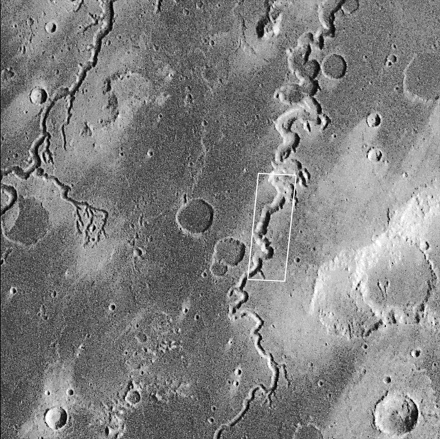 |
|
In Eberswalde Crater is a "fossil delta" that shows that Mars experienced ongoing, persistent flow of water over an extended period of time. It also shows that some sedimentary rocks on Mars were deposited in a water environment. Select the image to find out more details leading to these deductions. |
Fossil delta in Jezero Crater. Color-enhancing shows the clay-like (phyllosilicate-bearing) minerals (green here) that were carried into the lake, forming the delta. The clays would be a good place to look for signs of ancient life. The other colors are: olivine-bearing materials are colored yellow, low-calcium pyroxene-bearing materials are blue and purple–brown surfaces have no distinct spectral features. The Mars 2020 rover mission will land here. |
What makes Mars so intriguing is that there is evidence for sustained running liquid water in its past. Some geologic features look very much like the river drainage systems on Earth and other features points to huge floods. The Mars Pathfinder studied martian rocks in the summer of 1997 and found some rocks are conglomerates (rocks made of pebbles cemented together in sand) that require flowing water to form. Abundant sand also points to widespread water long ago. The larger and more advanced Mars Exploration Rovers (one called "Spirit" and the other called "Opportunity") further strengthened the conclusion in 2004 that there was liquid water on Mars in the past. Highly magnified images of the rocks examined by Opportunity (see image below) show a particular type of rippling patterns on the rocks that are formed under a gentle current of water instead of wind. In the image below the green stripes show the sedimentary layers laid down in flowing water and the blue lines show the boundaries between the layers. Furthermore, detailed chemical analysis of the compositions of the rocks by Opportunity show that they formed in mineral-rich water when the water got very concentrated with the minerals as the water evaporated (spectrum 1, spectrum 2, spectrum 3, spectrum 4, spectrum 5, spectrum 6 links).
In 2012 Opportunity found veins of the mineral gypsum near the edge of the large crater Endeavour. The gypsum veins show that water flowed through the rocks and they are even stronger evidence for water than mentioned above.
The Mars Science Laboratory, "Curiosity", landed in Gale Crater near the equator of Mars on August 5, 2012. It has a suite of instruments for identifying organic compounds such as proteins, amino acids, and other acids and bases that attach themselves to carbon backbones and are essential to life as we know it. It is also able to detect gases that could be the result of biological activity but it does not have the instruments to determine if there is currently existing biological activity going on. It will identify the best possible sites of biological activity (past or present) for a follow-up mission to more definitively confirm. Gale Crater is 155 kilometers (96 miles) across with a large mountain (Mount Sharp) inside it that is the remnant of an extensive series of deposits. The layers at the base of the mountain contain clays and sulfates that formed in liquid water. Curiosity is also investigating: the geology of the area to figure out how the rocks and soil formed; how the atmosphere has changed through time and the cycling of water and carbon dioxide; and the radiation environment at the surface (photons and particles from the Sun and the rest of the galaxy). See the William M Thomas Planetarium's MSL Landing page for more about Curiosity's landing sequence, see the first pictures returned from Gale Crater, and details on why Gale Crater was chosen.
The image above shows sections of the first 360-deg color pan of Gale Crater where Curiosity landed. The image was brightened during processing. The crater wall is visible on the left and right sides of the image and Mount Sharp is near the center of the image with the dark dunes near its base containing clays and sulfates that very likely formed in liquid water probably 3.5 billion years ago. The several gray splotches in the foreground were produced by the descent stage sky crane's rocket engines blasting the ground and blowing off the surface dust layer. Parts of the rover are visible as well. The black areas are places where the images making up the pan had not been all beamed to Earth yet.
At locations near where Curiosity landed in Gale Crater, it found deposits of gravel made of well-rounded pebbles eroded off of sedimentary conglomerate outcrops (left image). On Earth (right image of sedimentary conglomerate), rocks that are well-rounded are a common sign of rocks that have been transported by water in a river or stream. If the flow of water is great enough, the pebbles are lifted up in the flow or rolled along the bed and they get pounded against each other so the edges get rounded off. The sizes of the pebbles on Mars are too large to have been transported by wind; they must have been transported by a sustained, vigorous flow of water.
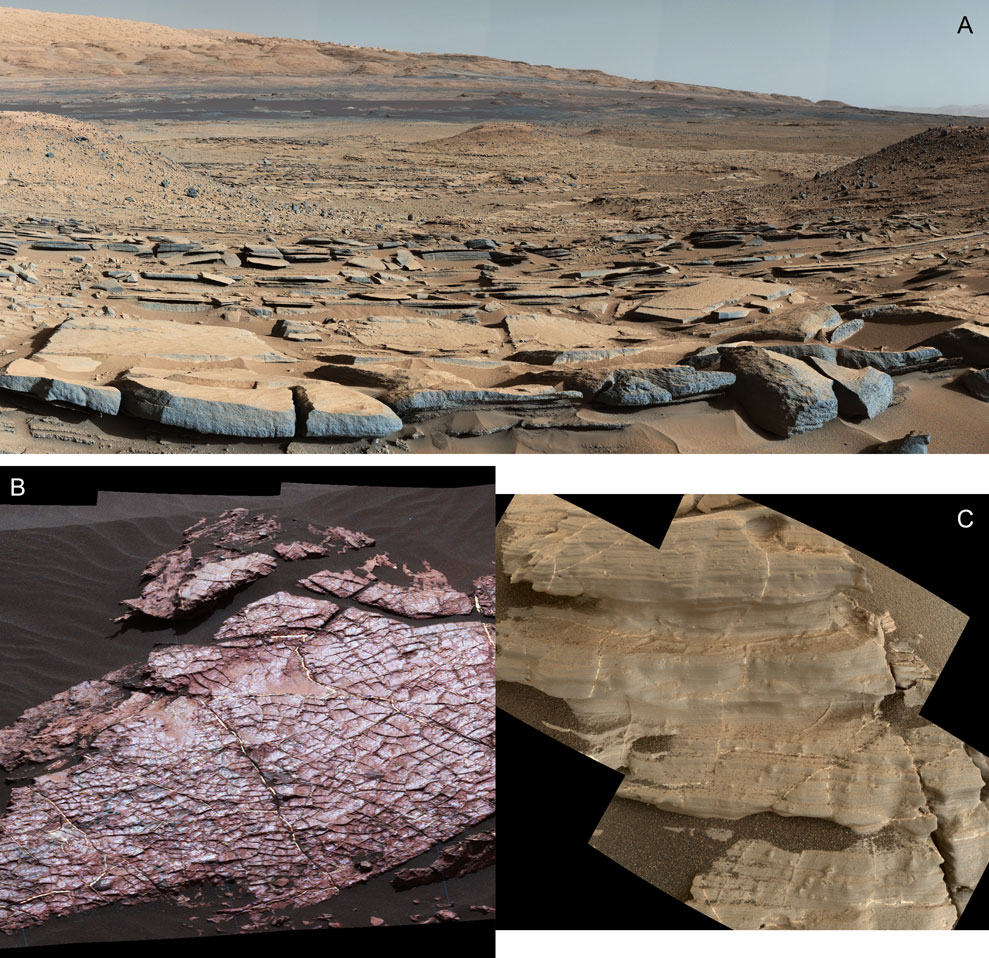
In the figure above, landscape features and details in the rocks show that part of Gale Crater was a lake (see the "A Guide to Gale Crater" video about this wet history). Picture A at top is the Kimberley formation taken by Curiosity on sol 580. The strata in the foreground dip towards the base of Mount Sharp, indicating flow of water toward a basin that existed before the larger bulk of the mountain formed. Picture B at bottom left shows a network of cracks in a Martian rock slab called "Old Soaker" possibly from drying mud. Image taken by Curiosity on sol 1555 in the Murray formation mudstone area. Mud cracks are from a time more than 3 billion years ago when wetter periods were interrupted by dry intervals. Picture C at bottom right is the rock called "Jura" taken by Curiosity on sol 1925. The various crystal-shaped bumps with swallowtail, "lark's foot" and star shapes are characteristic of gypsum crystals. This bedrock also exhibits mineral veins with both bright and dark material.
Features such as the gullies in the sides of craters provide a cautionary tale for how we have to be careful in assuming that water must be the cause of sinewy features (and how Mars can fool us if we are too Earth-like in our thinking!). The Mars Global Surveyor found places where gullies are etched into the sides of craters that themselves have very few smaller impacts inside of them. That means the crater walls are geologically young, so the gullies have to be even younger still. The orbiter also found gullies where bright new deposits were seen in images taken just four years apart from each other that seemed to be the result of water carrying sediments down the sides of the craters for a short time. However, the gullies formed mostly on the crater walls facing the poles. Also, the gullies were far more active (forming new features) in the southern hemisphere than in the north. These patterns better match the seasonal changes of carbon dioxide frost (dry ice) formation and then sublimation (when a solid turns directly to gas without the intermediate liquid phase). Mars' southern hemisphere winters are longer and colder than those in the north, so more frost forms and piles up in the southern hemisphere. As the dry ice sublimates it causes the rock and soil to flow downhill. Such action by dry ice can happen on Mars but not the Earth because Mars can get extremely cold---colder than Antarctica.
Even with this cautionary tale, there does appear to be evidence for liquid water flowing relatively recently. In 2011 the team of scientists working with the Mars Reconnaissance Orbiter (MRO) released images of seven craters where thin (0.5 to 5 meters wide) dark streaks are seen to flow down steep slopes repeatedly during the summer seasons when temperatures on the surface there can reach -23º to +27ºC (-10º to +80ºF). In an effort to not bias our interpretation of them, the team has called the features "recurring slope lineae" ("RSL" for short).

Select image for other craters with time-lapse images from the MRO press release
Mars' surface air pressure is much too low for pure liquid water to exist now. At very low pressure, water can exist as either frozen ice or as a gas but not in the intermediate liquid phase. If you have ever cooked food at high elevations using boiling water, you know that it takes longer because water boils at a lower temperature than at sea level. That is because the air pressure at high elevations is less. If you were several miles above the Earth's surface, you would find that water would boil (turn into steam) at even room temperature! However, if the liquid is very salty water, especially mixed with perchlorates, then it may be able to exist long enough to flow partway down the crater walls before freezing or evaporating. The dark streaks that grow during the warm summer time could be the result of liquid brines near the surface of Mars breaking through to the surface. Because of the widespread presence of salts on the surface of Mars, even pure water from below would get mixed with the salts. Unfortunately, the spectrometer on board MRO does not have sufficient spatial resolution to analyze the very narrow dark streaks.
Research teams tested the argument for these being the result of salty water flowing downhill by simulating the conditions (soil composition, low air pressure, and temperature) in the lab to see what all could create the dark streaks. In 2012 the MRO team increased the number of recurring slope lineae to 15 and strengthened their conclusion that they are caused by briny water melting and seeping downhill through the soil (see also link). However, a newer study in August 2016 seems to rule out the briny water idea. Using ground temperature measurements from the Mars Odyssey orbiter, the team found that there are no differences in temperature between slopes with the dark streaks compared to nearby slopes with no streaks, even when the dark streaks were growing. If the dark streaks were seasonal flows of briny water followed by evaporation, annual buildup of crust-forming salt should affect temperature properties.
The measurements put an upper limit of three percent water. That upper limit is as moist as the driest deserts on Earth. The temperature difference study also rules out the streaks being just powdery dust falling downhill after it accumulated too much from dusty air. More likely the salts in the soil become hydrated by pulling water vapor from the air through a process called deliquescence (see this link for how it could happen). The RSL features have now been found in more than 50 locations from the equator to about halfway to the poles. A 2017 study of the steepness of the slopes for over 150 RSL found that the dark streaks could be where grains of sand and dust slip downhill. The RSL are restricted to slopes steeper than 27 degrees and end at slopes too shallow for gravity to make a slope of loose material unstable. The seasonal changes in the flows and their coloring may be due to changes in the deliquescence hydration of the sand grains but that raises of the question of why RSL don't appear on all steep slopes.
In July 2018 a team using the MARSIS instrument on the Mars Express spacecraft (that has orbited Mars since 2003) announced the possible presence of a subglacial lake of water underneath the south polar ice cap. The MARSIS instrument sends out low-frequency radio pulses into the planet from a pair of boom antennae that each extend out 20 meters from the spacecraft. The radio waves can penetrate as much as three miles below the surface. Boundaries between layers of different materials can be good radio reflectors. The MARSIS team crunched the numbers from an intense observation campaign that ran from late May 2012 to late December 2015 and after a few years of looking at other possible explanations for an unusually radio reflective feature about one mile below the polar ice surface, the team announced its possible discovery for scrutiny by the larger scientific community.
The twelve-mile across feature’s temperature is probably about -68 deg C. Water could still be liquid at that very low temperature if there is a lot of salt, especially perchlorate salts, mixed in it to make it a very briny lake. Mars has plenty of perchlorates, so a liquid water buried lake is possible. However, another possible explanation is that the feature could be a muddy sludge. The SHARAD instrument on the Mars Reconnaissance Orbiter is also a ground-penetrating radar and it has not detected radio-bright features below the southern polar ice cap. Although SHARAD operates at a different radio frequency than the MARSIS instrument and can’t penetrate as far, it should be able to pick up the radar reflection from a briny lake. SHARAD would have a hard time detecting water-saturated sediments, so perhaps its non-detection means that the MARSIS instrument has found a pocket of muddy sludge instead.
Where there is liquid water, there is the possibility for life to arise. Tiny structures in a meteorite that was blasted from Mars in a huge impact of an asteroid look like they were formed by ancient simple lifeforms. However, there is still a lot of debate among scientists on that but strong evidence of contamination by terrestrial organic molecules has probably killed the possibility of conclusive proof of martian life in the meteorite. The dissenters are not wanting to be party poopers. They just want greater certainty that the tiny structures could not be formed by ordinary geologic processes. The great importance of discovering life on another world warrants great skepticism---``extraordinary claims require extraordinary evidence''. The search for martian life will need to be done with a sample-return mission or experiments done right on Mars. The intense scrutiny of the RSL features and the subglacial lake described in the previous paragraphs and the effort to find explanations for them that do not require much or any water are other examples of this scientific skepticism. When all other possibilities are exhausted, then we can be more confident in a water-based conclusion (and all the astrobiology possibilities that come with it).
The fact that Mars had sustained liquid water in the past tells us that the early Martian atmosphere was thicker and the surface was warmer from the greenhouse effect a few billion years ago. Some of the topics for follow-up research are: how long was there liquid water present on the surface; when did the liquid water disappear from the surface; how widespread was the liquid water; how much liquid water was there; and were there repeated episodes of liquid water appearing and then disappearing.
Life may have started there so current explorations of Mars are focusing on finding signs of ancient, long-dead life. An important step in that search is to determine how habitable Mars might have been long ago. Besides liquid water, life would need to have some source of energy to drive its metabolism. In early 2013, the Curiosity rover began drilling into the sedimentary rocks in Gale Crater. Drilling into the rocks may give us information about the conditions on Mars further back in time than what the Mars Exploration Rovers can give us with their wire brush tool.
The rock powder from Curiosity's first drillings were gray with a hint of green, not red, from olivine and magnetite that have less oxygen than the hematite found in rocks studied by the Mars Exploration Rovers. The range of oxidation of the materials in the rock could be used as a sort of chemical battery by micro-organisms. In addition, the reduced oxygen minerals would be better at preserving organics than the more oxidized rocks studied by the Mars Exploration Rovers. The rock studied by Curiosity has sulfur (including sulfur dioxide and hydrogen sulfide), nitrogen, oxygen, phosphorus, and carbon (in the form of carbon dioxide)---key ingredients for life. The presence of calcium sulfate and other minerals suggest that the clay minerals were formed from neutral or mildly alkaline water that wasn't too salty instead of the extremely high acidity and saltiness of the water that would have formed the rocks explored by the Mars Exploration Rovers. Examinations of other rocks in the Gale Crater area explored by Curiosity in late 2012-early 2013, show cracks between rocks filled with hydrated minerals that may indicate the Gale Crater floor was soaking wet more than once. In mid-December 2014 it was announced that organic compounds had been found by the SAM instrument on Curiosity. In June 2018, the research team added to the list of organic compounds to include sulfur-containing thiophenes, the hydrocarbons benzene and toluene, and small carbon chains such as propane or butene. The 2018 samples have a hundred times higher concentration of organic molecules than the 2014 samples. The June 2018 results also included three Martian years of seasonal variations in atmospheric methane. However, the organic materials and varying methane levels can be made by non-biological processes as well as the more exciting biological processes. The best we can say is that all the ingredients for life were present on Mars, Mars was habitable in the past, and biosignatures could be preserved in the rocks on Mars, just waiting for more advanced analysis to uncover them (such as the Mars 2020 and ExoMars missions). Curiosity is now climbing up Mt. Sharp to find out how the past habitability changed as it samples younger layers higher up.
The techniques we will use to find past life on Mars are pretty much the same as what we use to find when and where life got started on Earth. Biosignatures—ideal signs of ancient life—have to possess three characteristics: 1) they are compounds that are essential and unique to cellular processes; 2) they need to be stable for a LONG time (billions of years); and 3) the molecules need to be reasonably abundant enough for us to detect them.
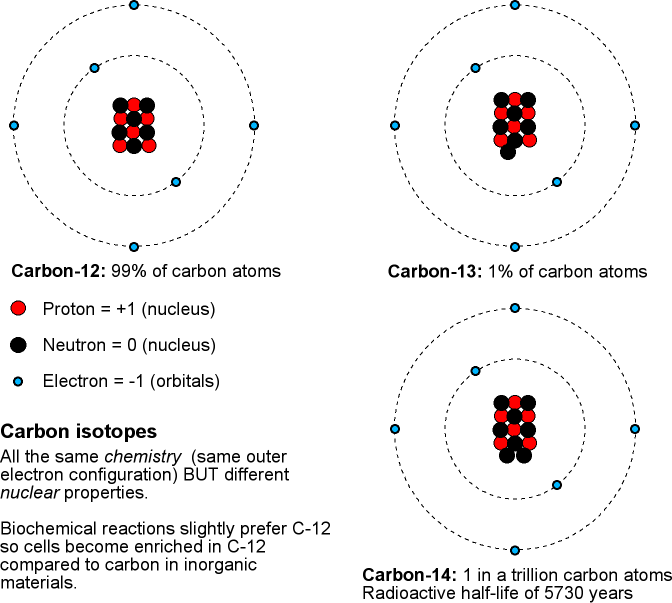 ---
---  ---
--- 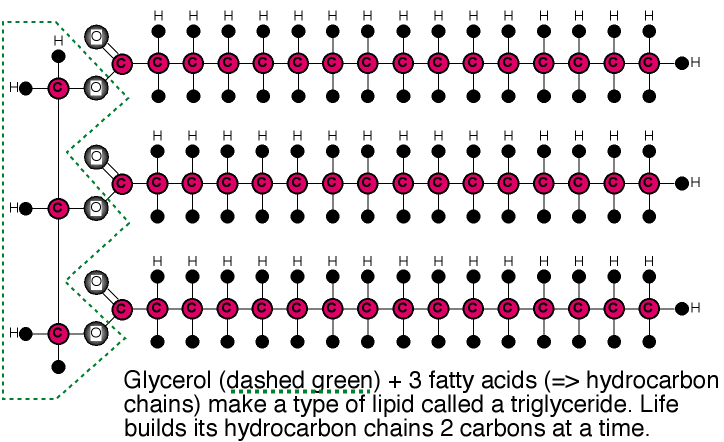 ---
--- 
select the images to enlarge them
For signature #1, we know that life is exceedingly choosy about the chemical building blocks it uses. That is good because that "pickiness" helps us distinguish a genuine biological remnant from a specimen produced by something else. In the sequence of pictures above, the far left one describes the carbon isotopes. Although both forms of carbon, Carbon-12 and Carbon-13, have the same chemical properties, Carbon-12 is a lighter form of carbon, so life enhances the amount of Carbon-12 in its reactions. Therefore, biological remnants will have a deficit of Carbon-13 compared to ordinary geological remains. Unfortunately, there has not been enough carbon in the rock samples and methane analyzed by Curiosity to do a conclusive analysis of the Carbon-13 deficit.
The next two pictures in the sequence above describe how terrestrial life has a peculiar way of building hydrocarbons (chains of carbon and hydrogen atoms such as fats and oils = lipids) that would leave a distinctive preference of hydrocarbons chains with even numbers of carbon atoms. The last picture in the sequence above describes how life also prefers working with particular types of polycyclic carbon compounds such as "sterols" (these include cholesterol and steroids) and "hopanoids" that stabilize cell membranes. Hopanoids are rarely found outside of living cells, so they are good biosignature molecules. They are also very hardy and can survive for billions of years.
Even though martian life might use different biological reactions than terrestrial life, a martian biosignature will still have to be something that enhances certain isotopes and molecule types beyond what ordinary geological and chemical processes will do. Besides organic compounds, other biosignatures include minerals in sedimentary rocks associated with life such as carbonates; chemical changes due to metabolic processes; micro-fossils, molds, or casts in the sedimentary rocks from microbes; and larger-scale structures from microbe colonies such as stromatolite and microbial mat formations. A rock sample examined by the Mars 2020 Perseverance rover will need to have at least several of these biosignatures in order to be considered to be a possible candidate for further study back at Earth. Furthermore, we need to consider the geological context of the candidate sample to make sure the rock unit containing the sample formed in a habitable environment and whether or not later processes affecting the rock unit could have formed the biosignature-like features through non-biological means ("abiotically"). Although Perseverance will have a sophisticated suite of instruments, there are some tests that can only be done with much larger equipment, so Perseverance will be caching rock core samples for later sample-return to Earth in 2031 (or later). For more details about finding ancient life on Mars see the open-access "Biosignatures on Mars" paper published in the journal Astrobiology and the 2013 technical paper by the Mars 2020 Science Definition Team covering the science goals of the Mars 2020 Perseverance mission and biosignature details.
Any lifeforms living now would have to be living below the surface to prevent exposure from the harsh ultraviolet light of the Sun. Mars has no protective ozone layer, so all of the ultraviolet light reaching Mars can make it to the surface. The Viking landers that landed in 1976 conducted experiments looking for biological activity, past or present, in the soil but found the soil to be sterile with no organic matter (in the top several centimeters at least). The soil is more chemically reactive than terrestrial soil from the action of the harsh ultraviolet light. More recently, the Phoenix mission described below in the "Ice on Mars" section found the reason for the lack of organic matter in the soil: perchlorate in the soil would break down any organic compounds that would have been in the soil when the soil was heated up during the Viking experiments. Curiosity also found perchlorates in the soil of Gale Crater. In any case, Mars appears to have undergone significant global change. What changed Mars into the cold desert of today?
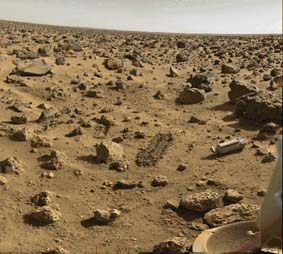 |
 |
Four views of Mars from four generations of Mars explorers: Viking 2 lander on top left, Mars Pathfinder on top right, Opportunity in the middle (much less rocky terrain---long picture!), and Curiosity on bottom (also a long picture!)
Mars Exploration Rover Sites movie (select the link to view a Flash movie showing where the Mars Explorations Rovers landed)
Mars Panoramas for Mars Travel Guide page has 4096x512 panorama images for planetarium show plus InSight and Perseverance panoramas created after the show.
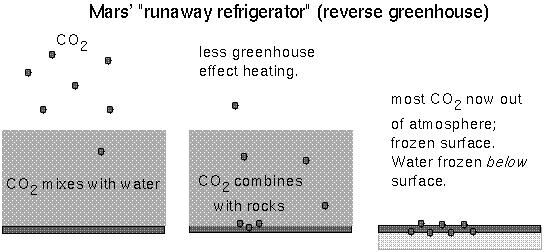
The runaway refrigerator is described in a flowchart on the Earth-Venus-Mars page. The flowchart up to the last dashed arrow occurred a LONG time ago. The box at the end describes the current state: frozen water and carbon dioxide below the surface and a very thin atmosphere.
The runaway refrigerator theory recently received further support when the Mars Reconnaissance Orbiter found places where deposits of iron and calcium carbonates had been uncovered at large impact sites great distances apart from each other. These types of carbonates form most easily in the presence of large quantities of liquid water and fit the runaway refrigerator idea of atmospheric carbon dioxide dissolving in bodies of liquid water. The carbonate layers are buried under a few miles (about 5 kilometers) of younger rocks, including volcanic flows, similar to what Spirit found when exploring Gusev crater. At Gusev Crater, Spirit had to climb the hills near where it landed to find the older minerals that formed in the presence of liquid water sticking above the surrounding crater floor covered in lava flows (see "Panel 1" of the "Follow the Water" forum). Large impacts are able to uncover the deeper carbonate layers, so MRO will explore other large impact craters closely to see how widespread the buried carbonate layers are.
Human explorers will need to use spacesuits on Mars' surface. The low pressure would kill them in a fraction of a second without something to provide an inward pressure on their bodies. Explorers will also need to contend with temperatures that are way below the freezing point of water even during the day and have enough shielding to block the abundant ultraviolet light and particle radiation from the Sun.
One of the predictions of the runaway refrigerator is that there should be water ice below the surface. Mars does have polar ice caps made of frozen carbon dioxide ("dry ice") and frozen water, but is there frozen water below the surface away from the polar ice caps? Yes!
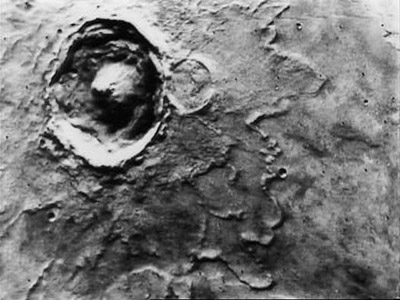
Yuty Crater is a type of crater called a rampart crater (or "splash crater") because of the distinctive ridges along the edge of the "fluidized" ejecta. This image from the Viking 1 orbiter as well as others it took of craters in the surrounding area show features formed when frozen (or liquid?) water was melted and mixed with the dirt and rocks to flow like mud upon impact (see also the image of Yuty Crater from the Mars Global Surveyor and a high-resolution image of the fluidized ejecta flow or link 2).
The Mars Odyssey spacecraft orbiting Mars found that the highest concentrations of the sub-surface ice are near the poles from about latitudes 60 degrees and higher. The Phoenix Mars Lander that landed at the end of May 2008 scooped up ice and soil at its landing spot near the martian north pole south of the north polar cap. It uncovered water ice just a few centimeters below the surface. Phoenix also ran tests to see if the soil & ice could be habitable for microbial life. Phoenix did not have the capability to detect biological activity; it could only determine if life could exist in the soil at its landing spot. The answer: maybe. Phoenix found perchlorate that is toxic to most Earth life but it can be food for some types of microbes (Curiosity has also found perchlorate in its location). Water vapor from the atmosphere could attach to the perchlorate to form a thin film layer of water for biological activity. In addition perchlorate in water can lower its freezing temperature enough to keep it liquid even in Mars' cold temperatures. A later study found that liquid water could form with the perchlorates in a different way than pulling water vapor from the air. In either case, it may be possible for small amounts of liquid water to exist on present-day Mars; enough for bacteria to live.
|
"Holy cow!" image from the robotic arm camera of the Phoenix Mars Lander shows what looks like ice uncovered by the rocket exhaust upon landing. |
Phoenix uncovered ice in this trench called "Dodo-Goldilocks" that sublimated (from ice directly to water vapor) over the course of four Mars days. The ice lumps seen in the lower left corner on day 20 are no longer there on day 24. If the ice was carbon dioxide, they would have sublimated away in less than a day at the temperatures of Phoenix's location when the trench was dug. |
The image above and others from the Mars Reconnaissance Orbiter show that frozen water is just below the surface at latitudes closer to the equator than thought possible before. The bright areas in the upper panels are are sub-surface water ice freshly exposed by meteorite impacts. They fade over 15 weeks as the water ice sublimates (bottom panels). See the MRO video archive for a nice video about this particular discovery (choose the September 24, 2009 video). These craters were near the location of the Viking 2 lander and the scientists figured out that if Viking 2 had been able to dig just 15 cm (6 in) deeper, it would have found the ice (33 years before Phoenix). An improved analysis in 2017 of data collected by the Mars Odyssey orbiter a decade earlier also points to sub-surface ice near the equator.
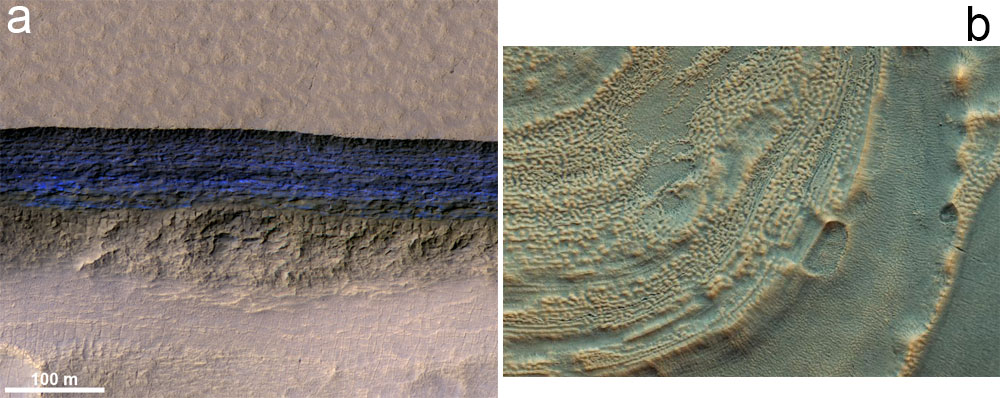
The figure above shows a couple examples of sites where thick deposits of ice are exposed at middle latitudes. Image a (left) is a deposit exposed in cross section that is relatively pure water ice (colored blue in this enhanced color view) and is capped by a layer of one to two meters of ice-cemented rock and dust. It is at latitude 56.6 degrees south. Image b (right) shows the edge of a mound of ice in a crater at 42.2 degrees north latitude. Some of it has already been removed, so we can see layering that used to be in the crater’s interior.
Given that there is water ice buried below the surface along with frozen carbon dioxide at the poles and locked away as carbonates, is it possible to use our technology to warm up Mars to make Mars habitable enough for humans to live on the surface without spacesuits, i.e., terraform Mars? Probably not using just the materials found on Mars. Too much of the necessary water and carbon dioxide have been lost to space. There is also the problem that a long-lasting atmosphere requires a magnetic shield from the solar wind and Mars lost its global magnetic field long ago. If Mars was the size of Venus or Earth, then it would probably still be habitable because it lies within the sun's habitable zone.
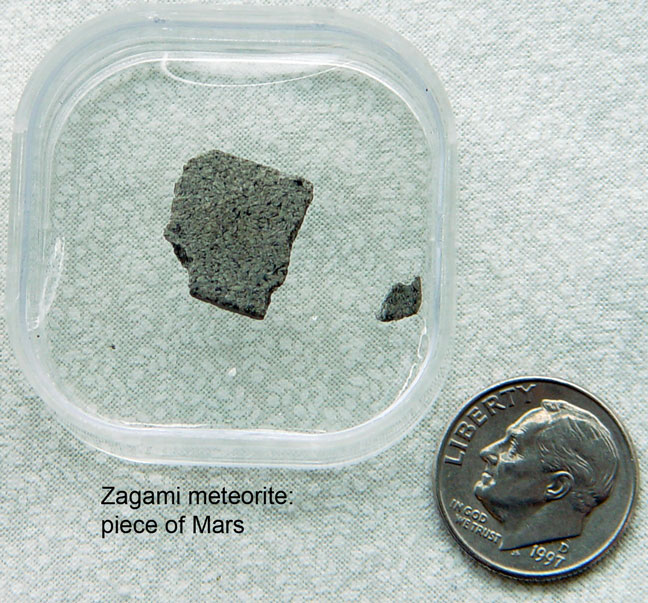
Some pieces of Mars are delivered to Earth as meteorites blasted from the surface of Mars from giant impacts. The ejecta from the blasts were moving fast enough to escape Mars' gravity and eventually find their way to Earth. The Zagami meteorite, named after the place in Nigeria where it landed in 1962, is one example. A small slice of it is shown above. At least several dozen martian meteorites have been discovered so far. Trapped gases in them closely resemble the atmosphere analyzed by Viking, their distinctive compositions (very different from regular meteorites), and, in most cases, much younger ages than regular meteorites, tell us that these particular meteorites came from Mars. Some of them have carbonates in them which again tell us that liquid water was once present on Mars.
And just for fun: Zoom in to the "Face on Mars". The "Face on Mars" is a remnant massif that attracted a lot of attention in the 1990s when a Viking 1 Orbiter picture of it, that made it appear like a face had been carved onto the martian surface, circulated around the web. Those with an over-active imagination thought the feature was artificial (made by ancient martian astronauts) and conspiracy theories were created of a NASA cover-up. The Viking image has poor resolution, poor lighting, and a number of "bit errors" that create black speckles, a couple of which were located at the feature's "nostril" and a "dimple" on its chin. Later much higher resolution images from the Mars Global Surveyor and Mars Express spacecrafts show it to be a naturally-occuring geologic formation. The "`Face on Mars' Zoom In" page shows where the "Face" is on Mars and increasingly higher-resolution views of the feature.
Finally, my notes from the January 13, 2011 update on the Mars Program.
![]() Go back to previous section --
Go back to previous section --
![]() Go to next section
Go to next section
last updated: May 16, 2024